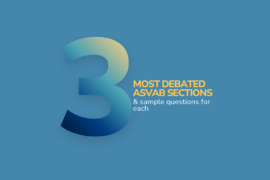Considering a career in military aviation? If so, you need to prepare for the ASTB-E (Aviation Selection Test Battery) exam, which is used by the U.S. Navy, Marine Corps, and the Coast Guard to evaluate and select pilot and flight officer candidates. The exam evaluates a candidate’s knowledge and ability to perform in a military aviation environment.
ASTB-E Basics
The ASTB-E is created and maintained by the Naval Aerospace Medical Institute (NAMI), a department within the Navy Medicine Operational Training Center (NMOTC) at Naval Air Station (NAS), Pensacola. Portions of the test are also used by the Navy for selection into Officer Candidate School (OCS). Because your selection—first, as an officer and second, as an aviator—hinges on your ASTB-E score, understanding and appreciating the details of the test are vital to your success when taking it.
The ASTB-E includes sections that focus on technical skills not found in previous versions, including aviation and nautical terminology, aircraft components and function, basic aerodynamic principles, and basic flight rules and regulations. Candidates with aviation and shipboard experience can use their experience to help them succeed on the ASTB-E, but those without experience can improve their scores in these sections by studying and using practice tests.
In addition, the test now incorporates a personality assessment that may influence the rest of your military career.
What’s included in the exam?
The ASTB-E is a multiple-choice computer test consisting of seven subtests that measure abilities essential in an aviation environment. The first five subtests adapt to the skill level of the candidate based on previous answers (computer adaptive).
- Math Skills Test (MST): This section is an evaluation of college-level mathematical terms and principles. Skills assessed include basic arithmetic operations, solving for variables, fractions, roots, exponents, and the calculation of angles, areas, and perimeters of geometric shapes.
- Reading Comprehension Test (RCT): This subtest evaluates your ability to read and comprehend technical or academic writing. The most common question types will ask you either to identify the primary purpose of the passage or to determine if a particular statement is supported by the passage.
- Mechanical Comprehension Test (MCT): This section tests your knowledge of basic physics, electrical, and mechanical theories. Questions focus on topics such as force, friction, current, fluid, pressure, pulleys, gears, screws, engines, and other machine operations. Physics, basic electronics, and mechanics courses will prepare you well for the questions in this section.
- Aviation & Nautical Information Test (ANIT): The ANIT is a knowledge test on aviation and nautical information. Aviation categories include aircraft components, aerodynamics, aerodrome operation, instrumentation, flight rules and regulations, and history. Nautical question categories consist of general carrier terminology, nautical terminology, history, and general terminology common to both aviation and nautical piloting.
- Naval Aviation Trait Facet Inventory (NATFI): The NATFI is a personality test used for officer candidacy and aviation selection and for use in mid-level officer career and command selection.
- Performance Based Measures (PBM): The PBM is administered on the APEX network and uses picture screens along with automated instructions. In addition to the APEX network, a throttle and joystick are used to interface within seven PBM subtests to measure situational awareness, dexterity, and multitasking elements.
- Biographical Inventory with Response Validation (BI-RV): The Biographical Inventory with Response Verification (BI-RV) test consists of 110 self-paced questions. This assessment takes between 45 minutes and 2 hours to complete. The purpose is to gather biographical and experiential information to help evaluate your ability to complete naval aviation training successfully, a key consideration for selection to aviation training.
Test takers can opt to take just the Officer Aptitude Rating (OAR) consisting of three subtests or the entire battery exam consisting of seven subtests.
How the test is administered
Two methods of test administration for the subtests that make up the OAR are available: paper and pencil, and the online APEX system. The number of questions and durations vary between the two formats.
Paper: You will encounter a fixed number and sequence of questions per subtest. Since any items left unanswered will be scored as incorrect, a good strategy is to eliminate invalid answer choices and make educated guesses on remaining questions if time is about to expire.
Online: The APEX system uses computer-adaptive programming for all of the subtests. Instead of a set number of questions over a set period of time, items in the question bank are ranked relative to their difficulty level. If you correctly answer a question, the next question will be more difficult. If you answer that question incorrectly, the test bank may provide an equally or less difficult question. The computer-adaptive format does not allow you to skip a question and come back to it later. All questions are forced responses, meaning that you have to submit an answer to each question in order to move on to the next question. NAMI advises against guessing because incorrect responses are counted against correct responses. That being said, you may need to make some educated guesses to answer the minimum number of questions, so pacing yourself to allow time to do so is important. Do not randomly guess near the end of the computer-adaptive tests. OAR only will take between 1.5 to 2 hours, and the entire battery will take between 2 to 2 hours and 15 minutes.
Preparing for the exam
Peterson’s test prep offers an online, timed ASTB-E practice test for sections one through five with detailed answers to every question to help you prepare for the exam.
A mandatory 30-day wait minimum is required before retaking the ASTB-E, and you must wait another 90 days before taking it for a third and final time.
Preparing for and earning a passing score on the ASTB-E exam will help your aviation career soar. Peterson’s can help you get here with the highest score possible.



